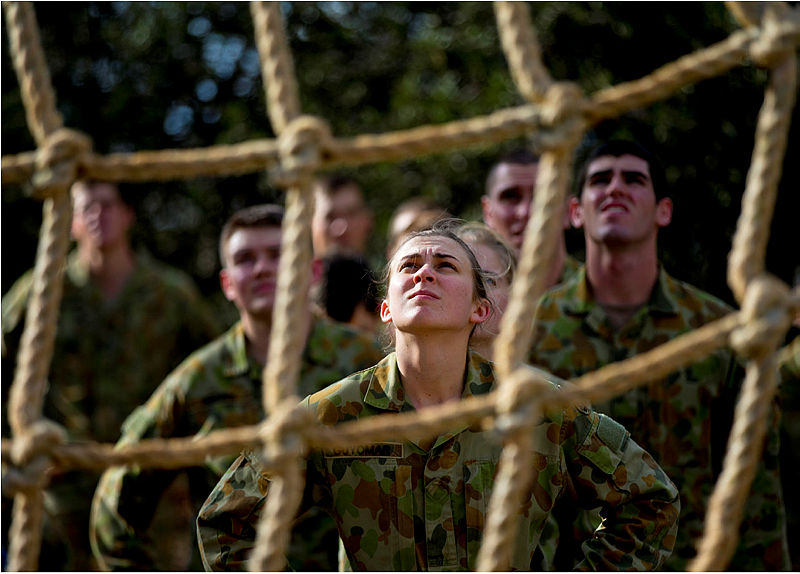
This article is part of a series on women, peace and security that The Strategist is publishing in recognition of International Women’s Day.
After more than three decades of research and advocacy, there’s increasing recognition of the link between ideas about masculinity and violence. Notions of manhood that centre on strength, emotional detachment, risk-taking and violent resolutions of disputes all shape conflict, propel men to join violent groups and hamper peacebuilding.
Yet, while the association between violence and maleness runs deep, it isn’t inevitable. Locally relevant targeted interventions can challenge men’s relationship with violence and dominance, and there’s been increasing investment in initiatives that work directly with men and boys in conflict-affected sites to transform harmful notions of masculinity.
Harmful notions of masculinity also shape state security institutions, but this has largely gone unaddressed by funders who have been enthusiastic about targeting men in conflict-affected sites. We know that harmful notions of masculinity within state institutions promote cultures of abuse, devalue women’s contributions and entrench homophobia.
Recent scandals in the peace and security sectors have forced some institutions to acknowledge the most egregious impacts that masculinities can have, but wide recognition hasn’t been forthcoming. Regressive notions about what it means to be a man are so pervasive that they can be difficult to identify in institutions where there are few visible alternatives. This is doubly so in institutions in which ideals of martial masculinity are venerated and become established through tradition.
Despite the gravity of the challenge, notions of masculinity are not immutable. In response to the increased visibility of men’s violence in Australia, there’s been considerable investment in research and programs focused on shifting men’s attitudes towards gender. Domestically, Australia has been a leader in funding programs to transform harmful masculinities through male advocates, awareness campaigns and school curriculums. Australia has also enthusiastically supported work by its neighbours to confront harmful gender norms. This challenging work has shown some promising results in shifting men’s ideas about violence and power.
Considering the growth of gendered work on men in other arenas, why has the security sector continued to treat ‘gender’ as a synonym for ‘women’?
To date, the Australian government’s approach to the women, peace and security agenda has not focused directly on men and masculinity. In line with the broader trend in WPS work globally, that work has been slow to develop. International examples have included programs on gender sensitivity, services for men in conflict-affected countries and efforts to engage men in gender equality.
Certain kinds of direct programs have proven effective in changing harmful notions of masculinity that facilitate violence and abuse. This programming should be integrated as a core part of training in the security sector and supported internationally in conflict-affected settings where appropriate.
Such a concerted effort would challenge attitudes that fuel gender-based violence and exclusory behaviour. It would contribute to the established pillar of prevention, working directly with people who are more likely to either perpetrate violence or create cultures of impunity for those who do.
Developing this direct programming would complement recent policy changes, such as the Australian Defence Force’s banning of death imagery that glorifies violence. Similarly, the need to combat the influence of harmful cultural products on Australian military masculinities, such as violent pornography and video games, was identified in a study by Major E.G. Boulton as an important step in breaking down barriers to women’s meaningful involvement in the ADF. Boulton’s study shows the pervasive impact of harmful masculinities on the ADF and the continuing need for direct work on its institutions. While targeted masculinity programs are hardly a panacea for the diverse ways that gender shapes peace and security in the Asia–Pacific region, an increased focus on and investment in shifting masculinities is likely to complement Australia’s existing work.
Further work is also needed to ensure that the Australian security sector reflects the diverse makeup of the country. The sector tends to be decidedly male-dominated, with overrepresentation of men in both civilian and enlisted roles. While these ratios are changing over time, the historical domination of security institutions by men has meant that the traditions and norms of those institutions tend to reflect masculine modes of behaviour.
Research on gender and institutional culture has emphasised that male-dominated institutions risk creating hostile environments for women, in which their contributions, perspectives and needs are marginalised or devalued. So far, the ADF has sought to increase women’s recruitment; however, without more widely challenging patriarchal values in the security sector, such a move risks becoming a quixotic effort to ‘make war safe for women’ rather than profoundly shifting violent masculinity.
Promoting women’s participation is one important step in challenging these tendencies, but should go hand in hand with understanding how ideas of masculinity create barriers to the meaningful participation of women and gender-diverse people.
It is no longer tenable to suggest that addressing gender in the security sector is a ‘women’s issue’. While the goals of the WPS agenda explicitly prioritise women, it’s men’s behaviour that creates the main barriers to achieving those objectives. That behaviour can and should change, so meaningful action is now needed in Australia’s security sector. By explicitly naming violent masculinities as a problem in Australia’s new national action plan on WPS, and making concrete commitments to shift harmful norms at home, Australia has the potential to address some of the root causes of women’s insecurity.
Editors’ note: This post has been amended at the request of the author to include a reference to the work of Major E.G. Boulton on the topic which was inadvertently omitted from the original draft.

